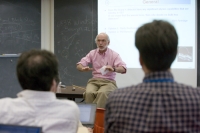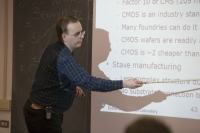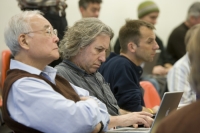 |
 |
|||||||||||||
|
|||||||||||||
|
|||||||||||||
|
At last week's Silicon Detector (SiD) concept meeting, participants used several words starting with the letter F -- Flow, as in particle flow; Funding, as in the need for more resources and manpower to fund detector R&D project; and Freezing, as in the weather at Fermilab. Approximately 70 members of SiD met at Fermilab to share the latest R&D results and plan for the future, namely how to prepare a draft Concept Design Report by this time next year. The SiD concept is currently one of four proposed detector designs for the ILC. In order to stay on the same timeline set out by the Global Design Effort for the machine, the international detector community must narrow down the selection from four concepts to two by the end of 2008. Getting from here to there for the four detector concepts is not such an easy process, making this a main topic of discussion for the SiD collaborators. “The most critical thing is that we go ahead with a SiD conceptual design,” said SLAC's John Jaros, one of the SiD Design Study Coordinators. “It has always been our goal, and we are getting pushed from the outside to do this now. To do that, we need to detail and integrate the subsystem designs, and we need a lot more engineering.” Writing a Concept Design Report will require the detector concept to focus on sharpening the SiD design, which may mean making some tough decisions. For example, particle flow algorithms (PFA) are a method of identifying all the particles that interact in the calorimeter. These PFAs hold a lot of promise for optimising the calorimeter design, but they are something that require more time to be proven successful. “We have made a lot of progress using PFAs, but they are very difficult,” said Argonne's Harry Weerts, who is also a SiD Design Study Coordinator. “They are so complicated, and it takes a long time to work on these things. I agree that it is the right approach, but we should pursue other options too.” Exploring other calorimetry options, such as dual readouts, is an avenue that SiD may pursue while also still pushing forward with particle flow. Expanding the calorimetry horizons will require more manpower though. “We encourage others to come and join us,” Weerts said. “The concepts are very short staffed, and we need to become more global and grow as a collaboration.” For a collaboration looking to expand R&D effort and recruit new members, funding was also a much discussed topic at the meeting. Paul Grannis, of the Department of Energy, presented a funding profile for the detectors and discussed the U.S. ILC Detector R&D Review, which will take place at Argonne on 19-20 June. “The funding profile and planned review show that a lot of progress has been made and marks real growth for the ILC detector R&D programme in the U.S.,” Weerts said. Some concern, however, remains within the community with regard to the scope of the detector R&D and the level of funding. While the meeting gave participants an opportunity to plan for future reviews and hear about the latest R&D results, the three-day workshop allowed the physicists and engineers to discuss all of these things face to face - something that a phone or videoconference can never substitute. To encourage discussions, Fermilab's Marcel Demarteau, one of the meeting organisers, arranged a SiD town hall meeting. Workshop attendees submitted questions ahead of time, but unlike prior town hall meetings, they got homework. In a “dueling piano” style, Demarteau forwarded each question to two random attendees and asked that they prepare a brief response for the meeting. “Sometimes the one answer would strengthen the other, and sometimes the two would strongly oppose each other, just like dueling pianos,” he said. “It created a much more interesting twist than the formal town hall meetings. It was intended to encourage a stimulating discussion, and it worked.” The SiD concept group expects to meet again in approximately six months. All talks from the meeting are available online. -- Elizabeth Clements |
|||||||||||||
| © International Linear Collider |



